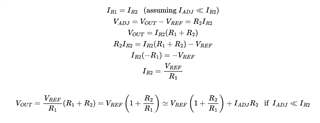Other Parts Discussed in Thread: LM1117
Tool/software:
Hi,
I'm working on a design where I use a couple of TLV1117 ICs in the adjustable version, and while looking at the datasheet, I noticed that the output voltage formula seems odd. It looks like the resistors R1 and R2 in the image (extracted from the datasheet) are inverted. Shouldn't R1 be above R2 instead of R2 above R1? An image of the typical application, extracted from the datasheet, is also included.
Best,
Rubén.




